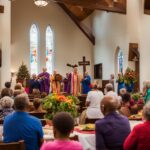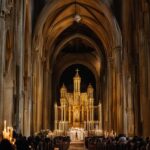The history of the Catholic Church is a rich tapestry that spans over two millennia. This timeline provides a concise overview of key moments and milestones in the evolution of the Church, from its earliest days in the 1st century AD to the challenges and transformations of the 21st century. It explores theological development, interactions with political powers, responses to social and cultural shifts, and the enduring commitment to faith and charity.
Key Takeaways
- The Catholic Church has a history that dates back to the 1st century AD and continues to the present day.
- Throughout its history, the Catholic Church has played a significant role in shaping religious, cultural, and political landscapes.
- The Church has faced challenges and transformations but remains committed to its core values of faith and charity.
- The timeline explores theological development, interactions with political powers, and responses to social and cultural shifts.
- Understanding the history of the Catholic Church helps us appreciate its enduring impact on the world.
1st Century AD: The Birth of Christianity
The 1st century AD marks a pivotal moment in history with the birth of Christianity. At the heart of this faith lies the crucifixion and resurrection of Jesus Christ, the Son of God. These events ignited a profound transformation, leading to the formation of the early Christian community. The teachings and beliefs of Jesus began to spread like wildfire through the passionate efforts of his disciples and followers.
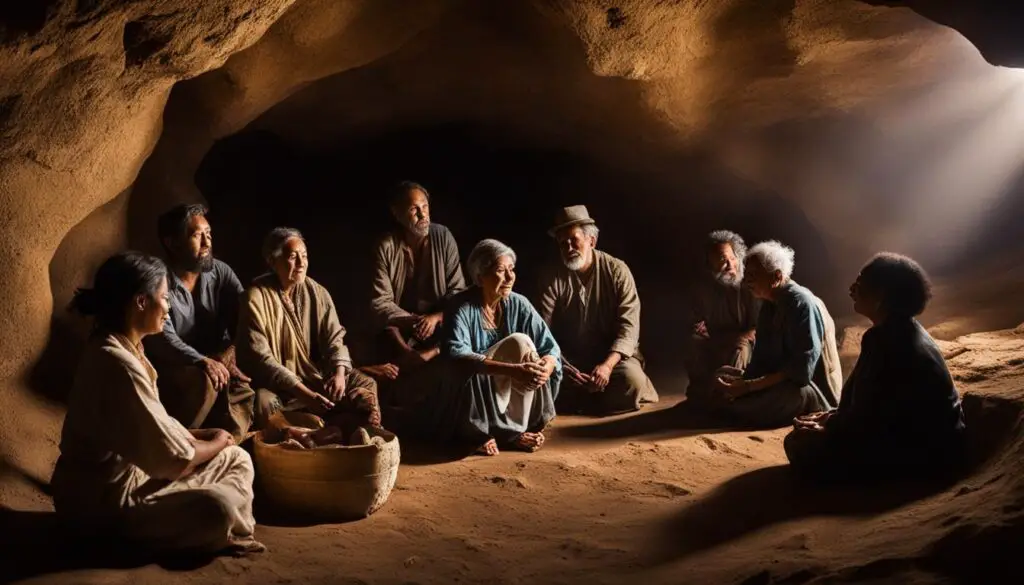
The crucifixion of Jesus Christ demonstrated the ultimate sacrifice made by the Son of God for humanity, while his resurrection provided hope and faith in eternal life. This momentous era laid the foundation for the growth and expansion of the Christian faith, setting in motion the journey of the Catholic Church that continues to this day.
“For God so loved the world, that he gave his only Son, that whoever believes in him should not perish but have eternal life.” – John 3:16
The early Christian community played a crucial role in nurturing and spreading the teachings of Jesus Christ. Their dedication and unwavering faith in the face of challenges solidified the formation of the Christian identity. The 1st century AD served as a transformative period that not only birthed Christianity but also created a spiritual movement that would shape the course of history.
The Early Christian Community
The early Christian community, led by Jesus’ disciples and apostles, held steadfast in their commitment to sharing the good news of the Gospel. They faced persecution and opposition from various quarters, but their faith kept them resilient. The teachings of Jesus and the principles of love, forgiveness, and salvation resonated with many, drawing people from diverse backgrounds into the fold of Christianity.
The early Christian community fostered a sense of unity and fellowship, gathering for worship, prayer, and the breaking of bread. They cherished the memory of Jesus, his teachings, and the miracles he performed. This profound faith and sense of community laid the groundwork for the rich tapestry of Christian traditions and practices that would develop and evolve over the centuries.
| Key Events | Description |
|---|---|
| Crucifixion of Jesus Christ | The sacrificial death of Jesus on the cross, a pivotal event in Christian theology. |
| Resurrection of Jesus Christ | The miraculous rising of Jesus from the dead, affirming the power of God and the promise of eternal life. |
| Early Christian Community | The formation and growth of the community of Jesus’ followers, spreading his teachings and expanding the reach of Christianity. |
This profound period in history set the stage for the remarkable journey of the Catholic Church, which has endured and thrived for over two millennia. The foundations laid in the 1st century AD continue to shape the beliefs, practices, and mission of the Church, attracting millions of faithful followers from all corners of the globe.
2nd-3rd Centuries: Expansion and Theological Development
During the 2nd and 3rd centuries, Christianity experienced a remarkable expansion throughout the vast Roman Empire, despite facing gruesome persecutions. The faith thrived and adapted to its challenging circumstances, with the early Christian community playing a pivotal role in both preserving and developing its theological foundations.
Key leaders emerged during this period, such as Ignatius of Antioch and Justin Martyr, who made significant contributions to the theological discourse of Christianity. Their writings and teachings solidified the faith and provided a solid basis for Christian theology.
The emergence of Christian texts also played a vital role in shaping the early Church. The Gospels and Epistles, including the works of Matthew, Mark, Luke, John, Paul, and Peter, became instrumental in spreading the teachings of Jesus Christ and guiding the community’s beliefs and practices. These texts served as sources of comfort, guidance, and inspiration for Christians.
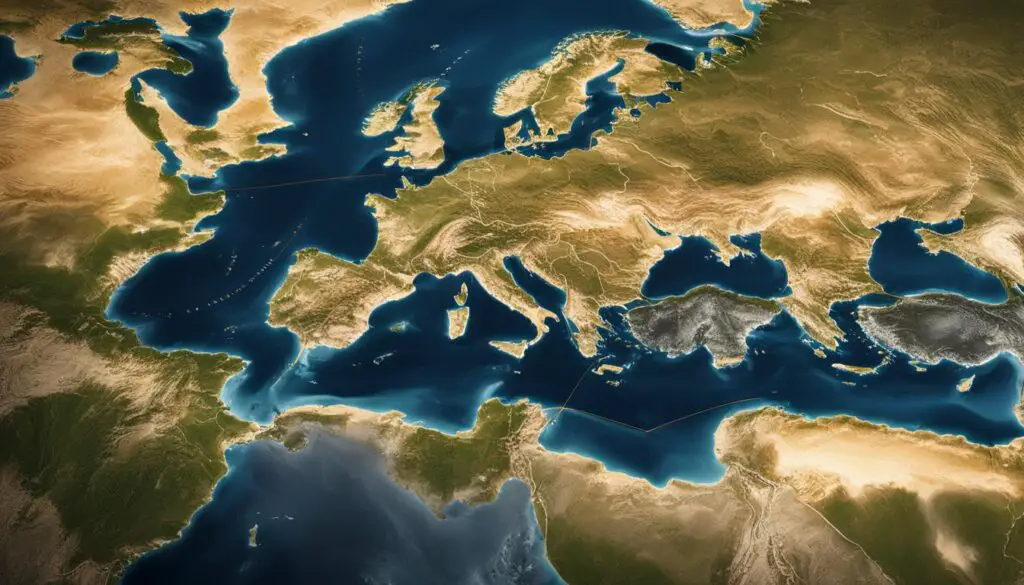
Despite the widespread growth of Christianity, the faithful faced relentless persecution from the Roman authorities. Christians were often subjected to torture, imprisonment, and even execution for their refusal to worship the Roman gods.
“The blood of martyrs is the seed of the Church.” – Tertullian
The persecutions, far from stifling the growth of Christianity, further strengthened the determination and resolve of the early Christian community. The steadfastness displayed in the face of adversity became a testament to their unyielding faith and dedication to the teachings of Jesus.
Throughout the 2nd and 3rd centuries, the expansion of Christianity and its theological development laid the groundwork for the faith’s future growth and influence. The commitment of the early Christian community, coupled with the emergence of crucial Christian texts, set the stage for the enduring impact of the Catholic Church.
4th Century: Constantine and the Council of Nicaea
In the 4th century, Emperor Constantine played a pivotal role in the history of the Catholic Church. His reign witnessed major developments that shaped the future of Christianity and solidified the Church’s influence.
Emperor Constantine issued the Edict of Milan in 313 AD, a groundbreaking proclamation that granted religious tolerance to Christians. This edict marked a significant turning point, ending the persecution of Christians and allowing them to practice their faith openly and freely.
One of the most significant events of the 4th century was the convening of the First Council of Nicaea in 325 AD. This council was called upon by Constantine to address theological controversies and unify the Christian Church.
“The First Council of Nicaea was a monumental gathering of bishops and theologians from across the Roman Empire. Their discussions and deliberations resulted in the establishment of key Christian doctrines and the formulation of the Nicene Creed.”
The Nicene Creed, formulated during the Council of Nicaea, became an essential statement of Christian faith that affirmed the divinity of Jesus Christ and solidified core theological beliefs. It played a crucial role in defining the boundaries of orthodoxy within the Church.
Under Constantine’s patronage and support, Christianity experienced rapid growth and expansion throughout the Roman Empire. Constantine’s conversion to Christianity and subsequent policies elevated the status and influence of the Church, shaping its future trajectory.
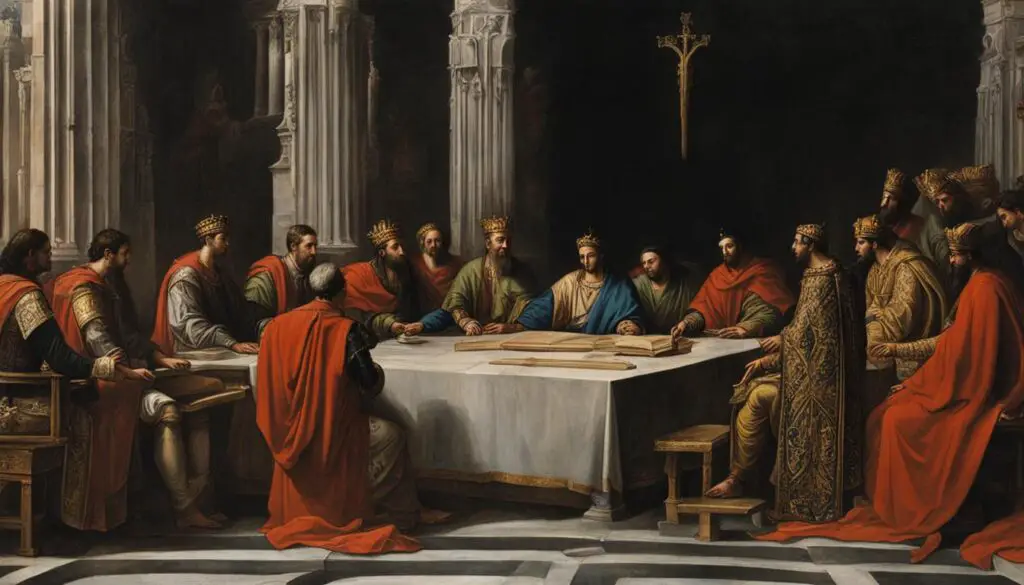
| Key Events and Developments | Year |
|---|---|
| Edict of Milan grants religious tolerance to Christians | 313 AD |
| First Council of Nicaea and the formulation of the Nicene Creed | 325 AD |
| Rapid spread of Christianity throughout the Roman Empire | – |
| Elevation of the Church’s status and influence under Constantine | – |
5th-7th Centuries: Expansion and Monasticism
The 5th to 7th centuries were a time of profound transformation in Europe. As Christianity continued to spread, the conversion of various European tribes played a pivotal role in expanding the influence of the Catholic Church. This period witnessed the establishment of religious orders and the rise of monasticism, which shaped not only the religious landscape but also the broader cultural and societal fabric of Europe.
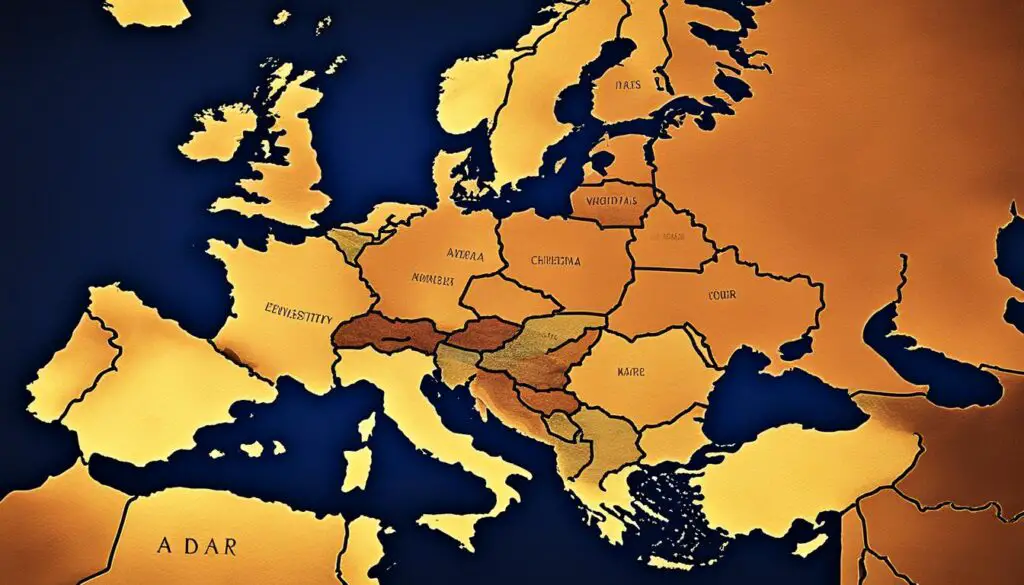
The Christian conversion of European tribes was a significant factor in the expansion of Christianity during this era. As these tribes embraced the faith, their customs, traditions, and even political structures became intertwined with Christian principles. The Catholic Church played a crucial role in spreading the teachings of Christ and assimilating these newly converted communities into the broader Christian community.
One of the notable developments during this period was the growth of monasticism. Monastic communities, such as the Franciscans and Dominicans, emerged as beacons of religious devotion and centers of learning. Monks and nuns dedicated their lives to prayer, meditation, and service, establishing a spiritual environment that fostered intellectual and cultural growth.
“The true monastery is obedience to the commandments, patience in afflictions, purity in thoughts, voluntary privation, bearing of the light yoke and meekness of heart.” – Saint Benedict
These religious orders became renowned for their charitable work, preserving knowledge through scriptoria, and offering guidance to the faithful. Monasticism provided stability and moral guidance during a time of political and social unrest, as well as a sanctuary of solace and spirituality amidst the uncertainties of the medieval world.
The expansion of Christianity in Europe and the flourishing of monasticism reshaped the spiritual, cultural, and educational landscape of the continent. The tireless efforts of the Catholic Church to spread the teachings of Christ and establish religious orders contributed to the development of a more cohesive Christian identity in Europe. This period laid the foundation for the religious and intellectual achievements that would follow in the centuries to come.
| Key Developments | Impact |
|---|---|
| Conversion of European tribes to Christianity | Expanded the influence and reach of the Catholic Church |
| Establishment of religious orders | Promoted spiritual growth, education, and charitable work |
| Growth of monasticism | Provided stability, intellectual nourishment, and moral guidance |
8th-11th Centuries: Charlemagne and Schism
In the 8th century, a significant figure emerged in Europe who would leave an indelible mark on the history of the Catholic Church and the Western world. Charlemagne, also known as Charles the Great, was crowned as the Holy Roman Emperor. This event symbolized a powerful alliance between the Church and political authorities, shaping the course of European history for centuries to come.
Under Charlemagne’s rule, the Holy Roman Empire experienced a period of political stability and cultural revival. He promoted Christianity and fostered the spread of the faith throughout his realm, leading to the conversion of many Germanic tribes. Charlemagne’s efforts in promoting Christian education and scholarship influenced the development of the Catholic Church in the Middle Ages.

The 11th century witnessed a significant schism that marked a turning point in the history of Christianity. The Eastern Orthodox Church and the Roman Catholic Church, once unified under the umbrella of the early Church, grew apart due to theological and cultural differences. This schism resulted in the separation of the churches in the East and the West, with far-reaching consequences that continue to shape Christianity today. The split between the Eastern Orthodox Church and the Roman Catholic Church highlighted differing approaches to religious authority, liturgy, and doctrinal matters.
| Significant Events | 8th-11th Centuries |
|---|---|
| Coronation of Charlemagne as Holy Roman Emperor | 800 AD |
| The spread of Christianity in the Holy Roman Empire | 8th-11th centuries |
| The Eastern Orthodox and Roman Catholic Church schism | 1054 AD |
The Impact of Charlemagne
Charlemagne’s reign had a profound influence on the relationship between the Church and political authorities. As the Holy Roman Emperor, he sought to establish a unified Christian empire, elevating the Church’s status and consolidating its power. Charlemagne’s support for the Church strengthened its influence in secular affairs, setting the stage for the interconnectedness of religion and politics that characterized the Middle Ages.
The Schism’s Consequences
The schism between the Eastern Orthodox Church and the Roman Catholic Church had significant implications for both religious institutions. The split created a lasting divide between Eastern Christianity and Western Christianity, leading to distinct theological, liturgical, and administrative traditions. This schism contributed to the complex religious landscape of Europe and influenced the development of different cultural and national identities within Christianity.
12th-13th Centuries: Middle Ages and Church Reforms
The 12th and 13th centuries were a significant period in the history of the Catholic Church, known as the Middle Ages. This era witnessed remarkable developments in cathedral construction, the establishment of religious orders, and important Church reform efforts.
The Magnificent Cathedrals of the Middle Ages
One of the defining architectural feats of the 12th and 13th centuries was the construction of magnificent cathedrals across Europe. These grand structures were characterized by their towering spires, intricate stained glass windows, and elaborate stone carvings. The construction of cathedrals became a symbol of the Church’s growing influence and wealth during this period.
The cathedrals served as centers of worship, education, and community gathering. They were awe-inspiring representations of divine power and human devotion. The most famous examples include Notre-Dame de Paris, Chartres Cathedral, and Canterbury Cathedral, which still stand as testaments to the craftsmanship and spiritual fervor of the time.
Founding of Religious Orders: Franciscans and Dominicans
The 12th and 13th centuries also witnessed the birth of two influential religious orders: the Franciscans and Dominicans. Saint Francis of Assisi founded the Franciscan Order, promoting a life of poverty, humility, and service to the poor. The order focused on inner spiritual transformation and emphasized the importance of simplicity and compassion.
Saint Dominic established the Dominican Order, centered on theological education, intellectual pursuits, and preaching. The Dominicans played a significant role in combating heresy and promoting scholarly study within the Church. Their commitment to preaching and teaching contributed to the spread of Christianity and the strengthening of Church doctrine.
The Fourth Lateran Council: Church Reform
During the 13th century, the Catholic Church addressed various reform issues in the Fourth Lateran Council of 1215 AD. This ecumenical council, convened by Pope Innocent III, aimed to reinforce Church discipline and strengthen the authority of the papacy.
“The Church, in this period of great transformation, recognized the need for internal renewal. The Fourth Lateran Council sought to address the challenges and concerns of the time, solidifying the Church’s role in society and promoting spiritual development.”
The council addressed topics such as the sacraments, clerical celibacy, religious doctrine, and the regulation of heretical movements. Its decrees impacted various aspects of Church life, shaping the organization and administration of the Church for centuries to come.
Overall, the 12th and 13th centuries were a time of remarkable change and growth for the Catholic Church. The construction of majestic cathedrals, the establishment of influential religious orders, and the efforts of the Fourth Lateran Council transformed and revitalized the Church during the Middle Ages.
14th-16th Centuries: Papal Schism and Reformation
The 14th to 16th centuries were a time of significant turmoil and transformation in the Catholic Church. This period was marked by two major events: the papal schism in the 14th century and the Protestant Reformation in the 16th century, both of which had profound effects on the Church.
The Papal Schism
In the 14th century, the Catholic Church faced a major crisis known as the papal schism. This schism occurred when there were multiple claimants to the papacy, creating a division and leading to confusion among the faithful. It lasted from 1378 to 1417 and resulted in the existence of two, and later even three, rival popes. The schism weakened the unity and authority of the Church, causing significant unrest among its followers.
The Protestant Reformation
In the 16th century, the Protestant Reformation, led by figures like Martin Luther, challenged the authority and doctrines of the Catholic Church. It questioned practices such as indulgences and highlighted the need for reform within the Church. The Reformation sparked a wave of religious and social upheaval, as individuals broke away from the Catholic Church and formed new Protestant denominations.
The Council of Trent: Catholic Church Response
In response to the challenges posed by the Protestant Reformation, the Catholic Church convened the Council of Trent. This ecumenical council, held from 1545 to 1563, addressed the issues raised by the reformers and sought to reaffirm Catholic doctrine, strengthen the authority of the papacy, and combat corruption within the Church. The Council of Trent played a crucial role in revitalizing the Catholic Church and clarifying its teachings.
| Key Features of the Papal Schism and Reformation | Papal Schism | Protestant Reformation |
|---|---|---|
| Causes | Dispute over the legitimacy of the papacy | Disagreements over Church practices and doctrines |
| Duration | 1378-1417 | 16th century onwards |
| Effects | Weakened the unity and authority of the Church | Formation of new Protestant denominations and challenges to Catholic teachings |
| Catholic Church Response | Convened the Council of Trent to address the issues and reaffirm Catholic doctrine |
Despite the challenges posed by the papal schism and the Protestant Reformation, the Catholic Church emerged from this period with renewed vigor and a greater focus on self-examination and reform. These events shaped the future trajectory of the Church and left a lasting impact on the religious landscape of Europe and beyond.
17th-18th Centuries: Catholicism Expands and Enlightenment
The 17th and 18th centuries were significant periods in the history of the Catholic Church, characterized by the expansion of Catholicism and the Enlightenment. During this time, the Church embarked on extensive missionary work, particularly in the colonized territories, spreading the teachings of Jesus Christ and establishing a presence in new regions of the world. This expansion played a pivotal role in shaping the global influence and reach of the Catholic Church.
The Church, however, also faced challenges during the Enlightenment, a period marked by the emergence of new ideas and philosophies questioning the influence of religion and the authority of established institutions. The Enlightenment thinkers prioritized rationality, science, and individual autonomy, challenging the traditional beliefs and practices upheld by the Church. Despite these challenges, the Catholic Church actively engaged with the intellectual and social debates of the time, seeking to reconcile faith and reason.
The period of Catholic expansion and Enlightenment was characterized by a delicate balance between the Church’s traditional teachings and the intellectual and social changes occurring in society. The Church played a role in addressing social issues and promoting charitable works, aligning with its longstanding commitment to serving the poor and marginalized. This era marked a dynamic phase for the Catholic Church as it navigated the changing landscape and sought to maintain its relevance and influence.
Catholicism Expansion in the 17th-18th Centuries
The expansion of Catholicism in the 17th-18th centuries can be attributed to the efforts of dedicated missionaries who ventured into newly discovered lands, bringing the message of Christianity to indigenous populations. One notable figure during this period was Saint Francis Xavier, a pioneering Jesuit missionary who traveled to Asia, including India, Japan, and China, to spread the Catholic faith.
Additionally, Catholic explorers and colonizers, particularly from Spain and Portugal, established Catholic missions and churches in the Americas, Africa, and Asia. These missions played a crucial role in the transmission of Catholicism and the integration of Christian practices into local cultures, leading to the formation of vibrant and diverse Catholic communities across the globe.
The Catholic Church and the Enlightenment
The Enlightenment period presented significant challenges to the influence and authority of the Catholic Church. Enlightenment thinkers, such as Voltaire, Rousseau, and Montesquieu, championed ideas of reason, individual liberty, and the separation of church and state. These philosophies called into question the power of religious institutions and advocated for a more secular society.
The Catholic Church, however, responded to the Enlightenment by engaging with the philosophical and intellectual discourse of the time. Many Catholic scholars and theologians sought to reconcile the principles of the Enlightenment with the teachings of the Church, emphasizing the compatibility of faith and reason. Prominent Catholic thinkers like Blaise Pascal and Johann Baptist Metz influenced Catholic intellectual traditions and offered thoughtful reflections on the challenges posed by the Enlightenment.
“Faith and reason are like two wings on which the human spirit rises to the contemplation of truth.” – Saint John Paul II
| Challenges to Church Influence during the Enlightenment | Responses of the Catholic Church |
|---|---|
| The rising prominence of secularism and skepticism | The Catholic Church emphasized the harmony between faith and reason, promoting philosophical arguments for the existence of God and the compatibility of religious beliefs with scientific knowledge. |
| Criticism of Church authority and doctrines | The Church engaged in theological debates, defending its teachings and doctrines through the writings and debates of theologians and religious scholars. |
| Demands for religious tolerance and freedom of belief | The Church acknowledged the importance of religious freedom and worked towards promoting interreligious dialogue and understanding while maintaining its commitment to the truth of the Catholic faith. |
The Catholic Church’s engagement with the Enlightenment reflected its resilience and adaptability to changing social and intellectual climates. By addressing the challenges of the Enlightenment and actively participating in the intellectual discourse of the time, the Church navigated a path that honored its traditions while remaining open to intellectual and social progress.
19th-20th Centuries: Vatican City and Modernization
In the 19th century, the dissolution of the papal states marked a significant turning point in the history of the Catholic Church. With the end of papal temporal power, the Vatican City was established as an independent city-state within Rome. Serving as the spiritual and administrative center of the Catholic Church, Vatican City remains a symbol of the Church’s enduring influence and global presence.
In the 20th century, the Catholic Church embraced modernization and actively engaged with social issues. One of the key milestones during this period was the Second Vatican Council, commonly known as Vatican II, held from 1962 to 1965. Vatican II aimed to renew and update the Church’s practices, bringing it closer to the contemporary world. This transformative event initiated numerous changes, including the adoption of vernacular languages in liturgy, increased participation of laypeople, and a renewed focus on ecumenism and interreligious dialogue.
Furthermore, the Catholic Church strengthened its involvement in addressing social issues that emerged in the 20th century. It addressed various concerns, such as poverty, inequality, human rights, and environmental stewardship. The Church’s commitment to social justice culminated in the publication of the encyclical “Rerum Novarum” by Pope Leo XIII in 1891, which marked the beginning of the Church’s official teachings on socio-economic matters.
Notable Church Involvement in Social Issues:
- Advocacy for worker’s rights and the dignity of labor
- Support for civil rights movements and racial equality
- Efforts to promote peace and reconciliation
- Championing the rights of refugees and migrants
- Addressing the global HIV/AIDS crisis
- Protection of the environment and environmental education
“We cannot live faith in Jesus without finding the courage to face injustice.” – Pope Francis
Challenges and Scandals
While the Catholic Church made significant strides in the 19th and 20th centuries, it also faced its fair share of challenges and scandals. One of the most significant scandals to emerge during this period was the sexual abuse crisis, which deeply impacted the Church’s credibility and prompted widespread calls for accountability and reform.
Instances of sexual abuse by clergy members came to light, revealing a widespread and systematic problem that had been concealed or mishandled by Church authorities. These revelations sparked outrage and led to efforts within the Church to address the issue, implement stringent child protection policies, and seek justice for survivors. The sexual abuse crisis remains an ongoing challenge that the Catholic Church continues to grapple with.
| Challenges and Scandals | Response and Reform |
|---|---|
| Sexual abuse crisis | Implementation of child protection policies, prosecution of offenders, and support for survivors |
| Internal conflicts and divisions | Efforts towards dialogue, reconciliation, and fostering unity |
| Secularization and declining religious practice | Renewal initiatives, evangelization, and outreach programs |
Despite these challenges, the Catholic Church’s commitment to spreading the message of love, justice, and compassion remains steadfast. It continues to navigate the complexities of the modern world, addressing social issues, promoting interfaith dialogue, and striving to uphold the teachings and values of the Gospel.
21st Century: Papal Successions and Ongoing Discussions
The 21st century has been a significant period for the Catholic Church, marked by the papacies of three influential leaders: John Paul II, Benedict XVI, and Francis. During this time, the Church has continued to address various social issues and face ongoing challenges.
Under the leadership of Pope John Paul II, who served from 1978 to 2005, the Catholic Church witnessed a renewed emphasis on faith and evangelization in the modern world. He played a crucial role in engaging with young people, promoting interreligious dialogue, and advocating for peace and justice.
Pope Benedict XVI, who succeeded John Paul II in 2005, focused on strengthening the theological foundations of the Church and addressing cultural relativism. His papacy saw the publication of the landmark encyclical “Caritas in Veritate” (Charity in Truth), which highlighted the Church’s commitment to social justice and the dignity of every human person.
Pope Francis, elected in 2013, has brought a renewed emphasis on mercy, compassion, and care for the marginalized. He has made headlines with his progressive stance on social issues such as poverty, climate change, and immigration. His papacy has been marked by humility, simplicity, and a desire to reach out to those on the peripheries.
In addition to leading the Church, these papal successions have sparked ongoing discussions and debates within the Catholic community. The Church engages in conversations regarding social issues such as contraception, women’s ordination, and same-sex marriage. These discussions reflect the evolving nature of society and the tension between tradition and modernity.
“The 21st century requires us to engage with the world in new ways, to confront the challenges of our time, and to remain faithful to the timeless teachings of Christ.” – Pope Francis
However, the Church also faces significant challenges and scandals in the 21st century. One of the most critical issues is the ongoing problem of sexual abuse cases involving members of the clergy. The Church has been working to address these cases, implement safeguards, and provide support for survivors. These scandals have tested the faith and trust of many within the Catholic community.
Despite these challenges, the Catholic Church remains a significant religious institution with a global impact. It continues to play a vital role in shaping moral and ethical discourse, providing spiritual guidance, and engaging in acts of charity and service.
| Pope | Papacy | Main Focus |
|---|---|---|
| Pope John Paul II | 1978-2005 | Evangelization, interreligious dialogue, peace, justice |
| Pope Benedict XVI | 2005-2013 | Strengthening theological foundations, cultural relativism |
| Pope Francis | 2013-present | Mercy, compassion, care for the marginalized |
Conclusion
The Catholic Church, with its long and complex history spanning centuries, has played a significant role in shaping the religious, cultural, and political landscape of the world. From its humble beginnings in the 1st century AD to the challenges and transformations of the modern era, the Church has endured and remained a beacon of faith.
Throughout its history, the Catholic Church has faced adversity and controversy. From periods of persecution to internal conflicts and scandals, the Church has weathered the storm, standing firm in its commitment to the teachings of Jesus Christ. It has continually sought to navigate the changing social, cultural, and political landscape while remaining faithful to its core tenets.
Despite the challenges it has faced, the Catholic Church remains a testament to the enduring power of faith. It has provided solace and guidance to millions of believers around the world, offering a sense of community, spiritual support, and a force for positive change. The Church’s commitment to charity, social justice, and the promotion of human dignity has made a profound impact on countless lives.
FAQ
What is the timeline of the Catholic Church?
The timeline of the Catholic Church spans over two millennia, from its earliest days in the 1st century AD to the present day. It includes key moments such as the birth of Christianity, the theological development of the early Christian community, the Council of Nicaea in the 4th century, the expansion of Christianity in Europe, the schism between the Eastern Orthodox Church and the Roman Catholic Church, the Middle Ages and Church reforms, the papal schism and Protestant Reformation, missionary work and the Enlightenment period, the modernization through Vatican II, and the challenges and discussions of the 21st century.
When did Christianity begin?
Christianity began in the 1st century AD with the crucifixion and resurrection of Jesus Christ. After Jesus’ death, his disciples and followers formed the early Christian community and started spreading his teachings and beliefs.
What were the early theological developments in Christianity?
The early theological developments in Christianity occurred during the 2nd and 3rd centuries. Leaders like Ignatius of Antioch and Justin Martyr contributed to theological discussions, and Christian texts such as the Gospels and Epistles were written, further solidifying the foundation of the Christian faith.
What happened in the 4th century that impacted the Catholic Church?
In the 4th century, Emperor Constantine issued the Edict of Milan, granting religious tolerance to Christians. The First Council of Nicaea was also convened, resulting in the establishment of key Christian doctrines and the Nicene Creed. This period saw the rapid spread of Christianity throughout the Roman Empire and elevated the status and influence of the Church.
How did Christianity expand in Europe during the 5th-7th centuries?
Christianity expanded in Europe during the 5th-7th centuries through the conversion of various European tribes. It was also a period of significant growth in monasticism, with the founding of religious orders like the Franciscans and Dominicans. These developments played a crucial role in shaping the religious and cultural landscape of Europe.
What important events occurred in the 8th-11th centuries?
In the 8th century, Charlemagne was crowned Holy Roman Emperor, strengthening the alliance between the Church and political powers. The 11th century saw the schism between the Eastern Orthodox Church and the Roman Catholic Church, which marked an important milestone in the relationship between the Church and secular authorities.
What were the main events of the Middle Ages in the Catholic Church?
The 12th and 13th centuries were the height of the Middle Ages in the Catholic Church. It was marked by the construction of magnificent cathedrals, such as Notre Dame in Paris, and the founding of religious orders like the Franciscans and Dominicans. The Church also addressed various reform issues during the Fourth Lateran Council in 1215 AD.
What was the impact of the Protestant Reformation on the Catholic Church?
The Protestant Reformation, initiated by Martin Luther in the 16th century, challenged the authority and doctrines of the Catholic Church. This led to the papal schism, with multiple claimants to the papacy, and sparked the Council of Trent, which was the Catholic Church’s response to the Reformation.
How did the Catholic Church engage with social issues and intellectual debates during the 17th-18th centuries?
The 17th-18th centuries witnessed the expansion of Catholicism through missionary work, particularly in the colonized territories. The Church also faced challenges during the Enlightenment period, with the emergence of ideas that questioned the influence of religion. This era saw the Catholic Church actively engaging with social issues and participating in intellectual debates.
What significant developments occurred in the 19th-20th centuries?
In the 19th century, the papal states were dissolved, leading to the creation of Vatican City. In the 20th century, the Catholic Church modernized through the Second Vatican Council (Vatican II) from 1962 to 1965. However, the Church also faced challenges and scandals, including cases of sexual abuse.
How has the Catholic Church addressed social issues and ongoing discussions in the 21st century?
The 21st century has seen the papacies of John Paul II, Benedict XVI, and Francis. The Catholic Church continues to engage in discussions on social issues such as contraception, women’s ordination, and same-sex marriage. It also confronts ongoing challenges and scandals, including cases of sexual abuse. The Church remains a significant religious institution with a global impact.
What is the significance of the Catholic Church’s history?
The history of the Catholic Church is a testament to the enduring power of faith and the teachings of Jesus Christ. Spanning centuries, it has shaped the religious, cultural, and political landscape of the world. Despite adversity and controversy, the Catholic Church remains a prominent institution in society, upholding its commitment to faith and charity.









